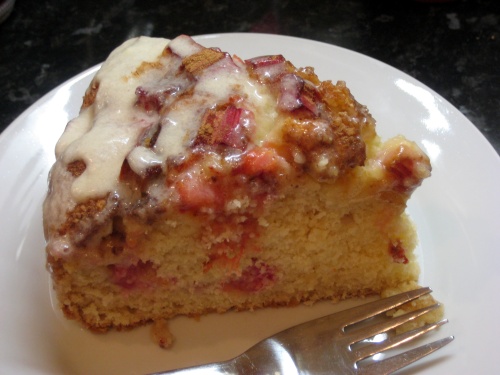Gluten-free rhubarb and ginger cake
This gluten-free batter produces a lovely light moist cake, and is extremely simple to make – it’s all done in the food processor. It’s based on a much-tinkered-with recipe first given to me at a teen cookery course run by the now-defunct South Australian Gas Company in the early 1990s. The original was flavoured with blueberry and lemon, and no doubt will appear on this blog at some point. I’ve since discovered that the base mixture adapts brilliantly to gluten-free – I imagine because of the cream cheese and yoghurt.
Ideally you want slim, pale pink wands of rhubarb for this recipe, the kind that appear in late winter (in Scotland, right now). The icing uses fresh ginger juice and therefore requires an electric juicer. If you don’t have a juicer (or want to serve the cake warm), just leave off the icing and serve with something creamy and ginger-flavoured, such as Rachel’s Organic Greek Style Ginger Yoghurt, or a stem ginger ice-cream.
Serves 8
2 tsp finely grated fresh ginger (use a Microplane grater or similar for best results)
1¼ cups (260g) caster sugar (ideally golden, but regular is fine)
50g unsalted butter, softened
125g Philadelphia cream cheese (full fat)
2 large eggs
2 cups (360g) gluten-free plain flour mix (I use Doves Farm – Orgran is also good)
1 tsp bicarbonate of soda
¼-½ cup yoghurt (4% fat)
300g rhubarb (trimmed weight), cut into 1cm pieces
For the topping
⅔ tsp ground ginger
1⅓ tsp cinnamon
scant 3 tbs demerara sugar (40ml)
For the icing
1 cup (160g) icing sugar (not icing mix)
generous 1 tbs butter, softened (20ml)
35ml fresh ginger juice (I needed about 60g fresh ginger to yield this much juice – no need to peel before juicing – but juicers vary)
You will also need a 24cm round springform cake tin, lightly buttered, base and sides lined with baking parchment.
Preheat the oven to 190C. Place the sugar and grated ginger in a food processor and pulse briefly to mix. Add the softened butter and cream cheese and process until smooth. Mix in 1 egg and 1 tbs of flour; process briefly. Add remaining egg and process again.
Add the flour and bicarb with ¼ cup of yoghurt. Process briefly in bursts until batter is just mixed. Add enough of the remaining yoghurt to make a soft chopping consistency (not too stiff and not too runny). Process till just combined – do not over-mix.
Spread half the mixture over the base of the cake tin, and distribute half the rhubarb evenly over the batter. Cover with the remaining batter – it’s easiest to do this by dropping small dollops of batter at intervals across the fruit, then gently spreading with a spatula. (It doesn’t matter if some fruit shows through.) Sprinkle the remaining rhubarb on top.
Mix together the demerara sugar and spices for the topping, and sprinkle evenly over all. Bake for 50-60 minutes, until a skewer inserted in the centre of the cake comes out clean. Remove the sides of the cake tin and leave the cake to cool before icing.
Make the icing while the cake is cooking. Place the softened butter in a medium mixing bowl. (It needs to be very soft, but not melted.) Add the icing sugar and half the ginger juice to start with, and whisk well with a balloon whisk. Add more ginger juice, drop by drop, until you have the right consistency and any lumps of butter are whisked away. (You may need a little more or less than 35ml juice in total.) You are aiming for an icing that is only just thin enough to pipe in drizzly rows – too thin and the rows will spread into a messy sheet over the top of the cake.
Take a snaplock sandwich bag (the kind required under airport liquid rules) and sit it upright in a large mug, with the snaplock top open and turned down over the top of the mug. Scrape the icing into the bag using a spatula, then remove the bag from the mug, expel any air, and seal. Store the icing in the fridge until needed. (If you are serving the cake away from home, you can transport the icing in its bag and ice the cake at your destination.)
When the cake is cool and you are ready to ice it, remove the base and baking paper and place on a serving plate. (Don’t try to ice the cake warm or the icing will melt – as you can see in the photo!) Snip a tiny corner off the icing bag and drizzle the icing across the cake. I do two sets of rows perpendicular to one another, to form a drizzly criss-cross pattern. Slice using a large serrated knife and serve.
